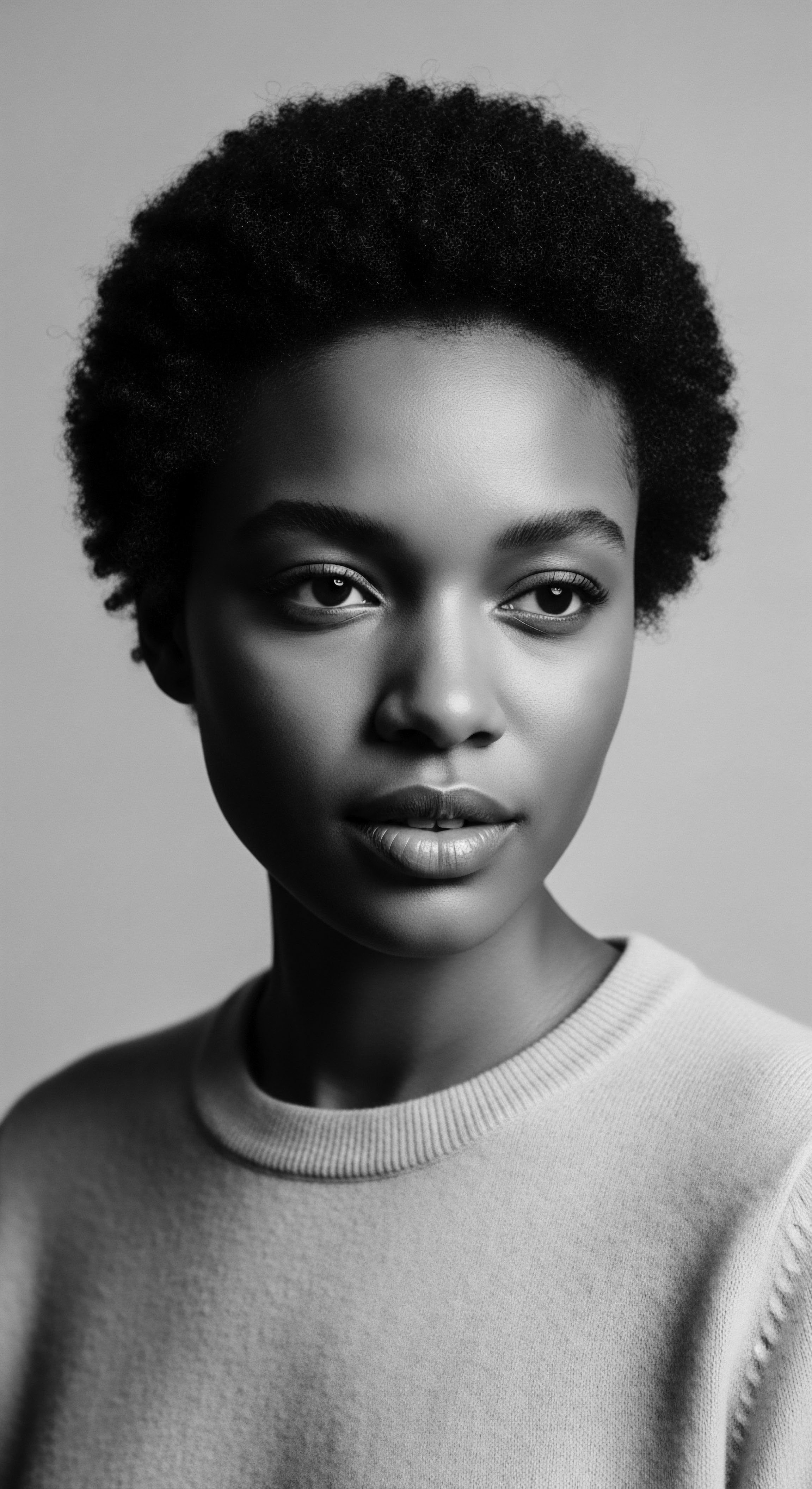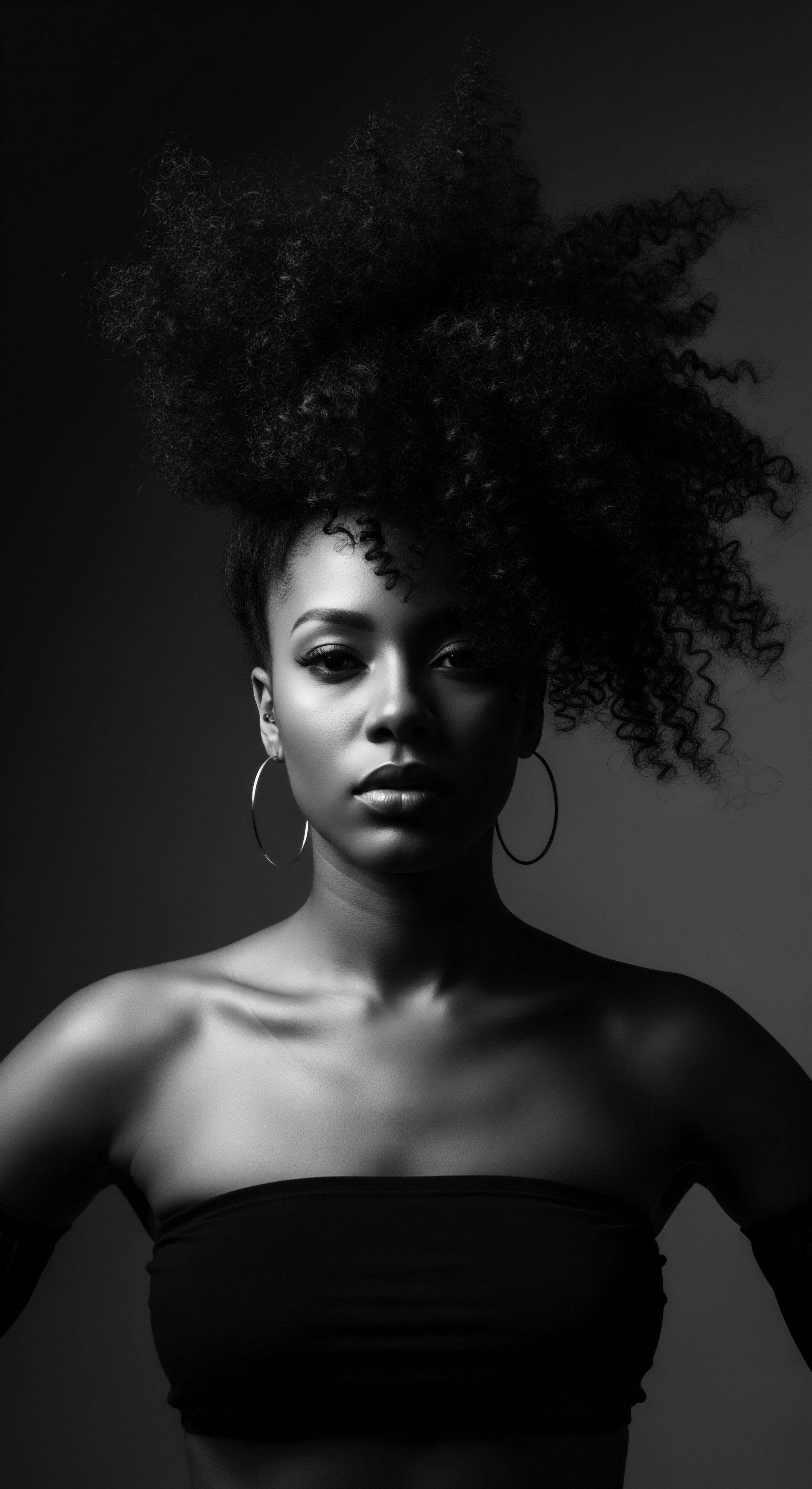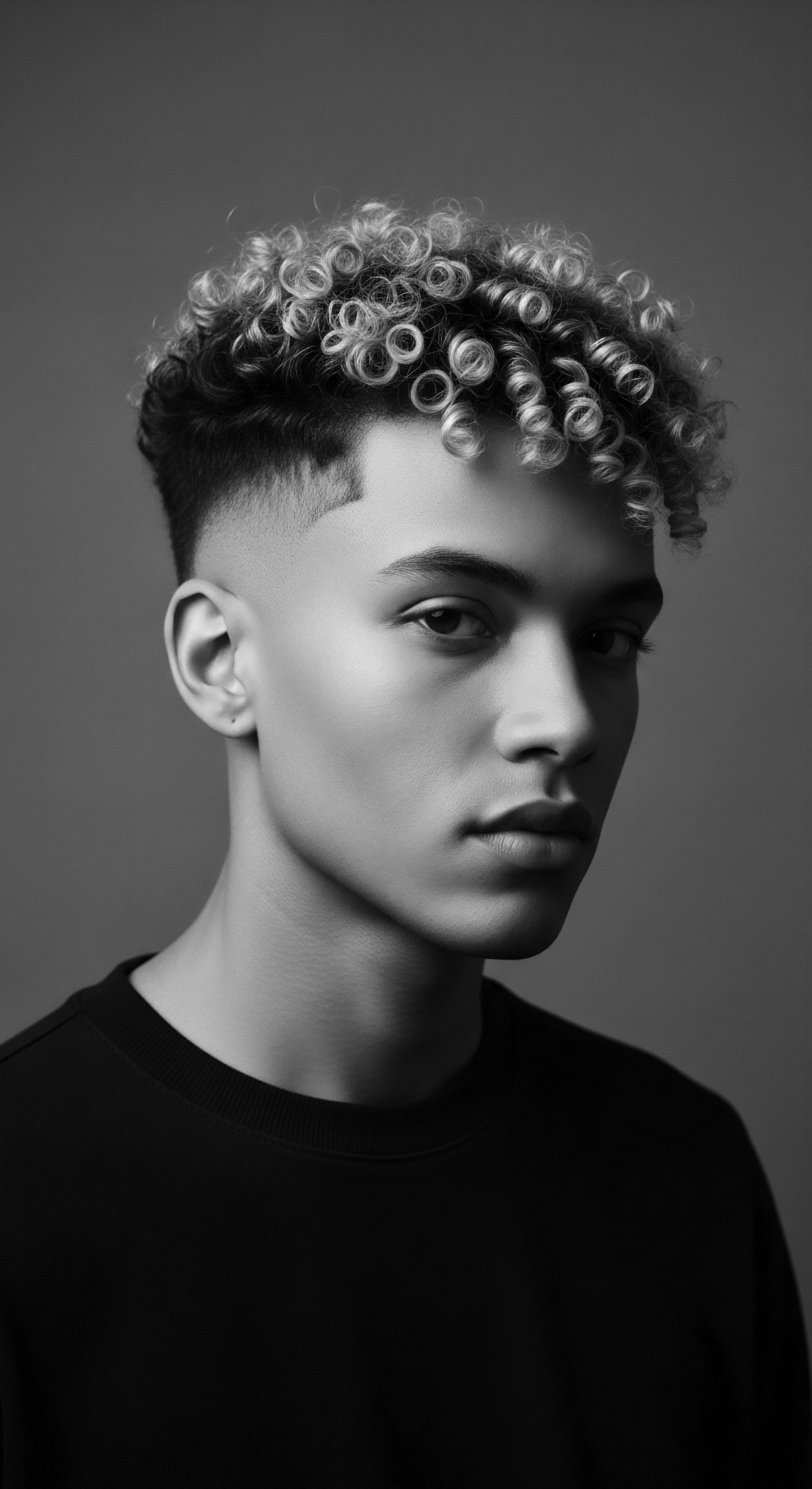
Roots
The very architecture of hair that crowns the heads of so many within the African lineage holds a profound story, a narrative not etched in parchment, but in the spiraling helix of keratin itself. What wisdom might these tightly coiled strands hold concerning their emergence, their resilience, and their indelible connection to a heritage stretching back to humanity’s earliest dawn? This inquiry takes us on a journey, a voyage into ancestral memory and the deep biological impulses that shaped our forebears, seeking to truly grasp why this particular hair form became a hallmark of the African experience. It is a dialogue between the elemental forces of nature and the biological ingenuity of early humankind, revealing a story of survival and thriving, intrinsically linked to the environments of their origin.

The Sun’s Embrace and Hair’s Answer
Consider the intense equatorial sun, a radiant presence in the cradle of humanity. This powerful light brings warmth and life, yet also poses significant challenges, particularly concerning thermal regulation for early humans navigating open savannas and sun-drenched landscapes. The human brain, a remarkably complex and energy-intensive organ, is particularly susceptible to overheating.
For millennia, before hats or elaborate shelters were readily available, our very biology provided ingenious solutions. One such solution, a marvel of biological adaptation, arose in the form of hair.
Studies into thermoregulation suggest that tightly coiled hair excels at creating a microclimate around the scalp, effectively trapping a layer of air that acts as insulation. This mechanism helps to reduce the amount of direct solar radiation absorbed by the scalp, thereby mitigating heat stress on the brain. A unique advantage of this hair structure is its ability to stand away from the scalp, resisting collapse even under humid conditions. This characteristic fosters air circulation and allows sweat to evaporate more efficiently, aiding in cooling.
Dr. Tina Lasisi, a biological anthropologist, notes that early humans with more tightly coiled hair likely experienced superior heat dissipation from the scalp, a critical factor for survival and cognitive function in intensely hot, high-UV environments (Lasisi, 2021). This biological function intertwines with the earliest human endeavors, shaping the very survival of our ancestors.

How Did Coiled Hair Offer Unique Protection?
The protection offered by coiled hair extends beyond thermal regulation. The dense, spring-like structure provides a robust physical barrier against the sun’s ultraviolet radiation. UV exposure poses a significant threat, leading to DNA damage, skin cancer, and folate degradation. While skin pigmentation offers a primary defense for the body, the scalp, directly exposed and highly vascularized, requires additional safeguarding.
The sheer density and the fractal-like arrangement of tightly coiled strands create a shield, scattering incoming UV rays and minimizing their penetration to the sensitive scalp. This natural sunblock allowed early Africans to navigate their sun-soaked environments with greater resilience.
Moreover, this hair structure also played a role in mitigating insect bites and abrasions. The dense, springy network of strands made it more challenging for parasites to reach the scalp, an often-overlooked aspect of its protective utility. As our ancestors moved through varied terrains, this inherent barrier would have offered subtle yet significant benefits, reducing discomfort and potential for infection. The hair, therefore, was not merely an appendage; it was an integral part of an adaptive suite, working in concert with other biological features to ensure well-being.
Tightly coiled hair represents a sophisticated biological adaptation, a testament to ancestral ingenuity in navigating intense equatorial environments.
The morphological characteristics of hair, particularly its cross-sectional shape and the degree of curl, are determined by the shape of the hair follicle and the angle at which it emerges from the scalp. Follicles that produce tightly coiled hair tend to be elliptical or flattened in cross-section, with a strong curl bias that causes the hair shaft to twist as it grows. This twisting contributes to the tight coiling. The growth pattern is also influenced by the distribution of keratin proteins within the hair shaft, which is not uniform, further contributing to the characteristic curl pattern.
This biological predisposition for tight coiling, coupled with its adaptive advantages, suggests a strong selective pressure in the African environment. Over countless generations, individuals whose hair offered superior protection against heat and UV radiation would have had a survival advantage, passing on the genetic traits for this hair type. This gradual process, guided by the immense forces of natural selection, sculpted the diverse hair textures we recognize today within the African diaspora, each strand a living archive of this ancient legacy.
| Hair Characteristic Tight Coiling |
| Evolutionary Advantage in Africa Superior thermoregulation for brain cooling in hot climates. |
| Scientific Mechanism Creates an insulating air layer close to the scalp, reducing direct heat absorption and promoting sweat evaporation. |
| Hair Characteristic High Density |
| Evolutionary Advantage in Africa Enhanced UV radiation protection for the scalp. |
| Scientific Mechanism Acts as a physical barrier, scattering UV rays and limiting their penetration to sensitive skin. |
| Hair Characteristic Elliptical Follicles |
| Evolutionary Advantage in Africa Underlies the tightly coiled growth pattern. |
| Scientific Mechanism Causes the hair shaft to twist and curl, leading to its spring-like structure. |
| Hair Characteristic The intricate relationship between hair morphology and environmental pressures underscores the deep evolutionary history of textured hair. |

Ritual
As human societies blossomed across the continent, the very strands that offered biological safeguarding began to weave themselves into the fabric of culture, becoming far more than mere protective covering. They became living canvases, symbols, and expressions of identity, belonging, and belief. The evolution of tightly coiled hair set the stage for a rich heritage of styling and care, transforming a biological feature into a profound cultural statement. This journey from elemental biology to communal expression is a testament to the ingenuity and spiritual depth of African communities, where hair rituals became integral to daily life and rites of passage.

How Did Ancestral Practices Shape Hair’s Cultural Role?
The natural resilience and unique structure of tightly coiled hair lent themselves beautifully to a myriad of protective and decorative styles that transcended mere aesthetics. From the ancient Kemet (Egypt) to the sprawling kingdoms of West Africa , hair was sculpted into elaborate forms. Consider the Igbo people of what is now Nigeria, whose intricate threaded styles, often adorned with beads or cowrie shells, conveyed messages about social status, marital availability, and even spiritual protection.
These styles, while visually stunning, also offered practical benefits, protecting the hair from environmental damage and reducing breakage, a wisdom passed down through generations. The very act of styling was often communal, an intimate moment shared between women, strengthening familial bonds and transmitting cultural knowledge.
In many traditional African societies, hair carried immense symbolic weight. A person’s hairstyle could signify their age, lineage, wealth, religion, or even their emotional state. In some Maasai communities, young warriors would grow their hair long and intricately braid it with red ochre and animal fat, a powerful display of virility and status.
Older, respected women might wear their hair in close-cropped styles or distinct patterns that marked their wisdom and matriarchal role. These expressions were deeply embedded in the social structure, making hair a silent, yet eloquent, communicator of one’s place within the collective.
Hair rituals in ancestral African societies were not merely cosmetic; they were profound expressions of identity, social standing, and communal wisdom.

The Art of Preservation and Adornment
The unique qualities of tightly coiled hair required specific care regimens, which gave rise to generations of accumulated knowledge about natural ingredients and methods. These ancestral practices formed the bedrock of what we now recognize as holistic hair wellness. Natural oils and butters, such as Shea Butter from the karite tree, Palm Oil, and Argan Oil, were widely used to moisturize, condition, and protect the hair. These substances, rich in fatty acids and vitamins, prevented dryness and breakage, preserving hair health in challenging climates.
- Shea Butter ❉ Revered across West Africa for its deeply emollient properties, it was used to seal moisture, protect from sun damage, and soothe the scalp.
- Palm Oil ❉ A staple in many Central and West African diets, it also served as a nourishing hair treatment, providing vital nutrients and shine.
- Marula Oil ❉ Utilized in Southern African communities, its light texture and high antioxidant content made it ideal for conditioning and adding luster.
Beyond oils, various plant extracts and clays were employed for cleansing, strengthening, and even coloring. The Kigelia africana fruit, for example, was used in parts of Southern Africa for its cleansing and restorative properties. These practices were not random acts; they were integrated into daily life, often performed as part of morning rituals or evening preparations, ensuring the hair remained vibrant and honored. The careful selection of natural ingredients, rooted in local flora and ancestral understanding, highlights a deep connection to the land and its offerings.
The tools of styling were equally important, evolving from natural materials to specialized instruments. Combs carved from wood or bone, Hairpins fashioned from metal or ivory, and various threads for wrapping and braiding were commonplace. These tools were often works of art themselves, reflecting the aesthetic sensibilities and craftsmanship of the communities that produced them. The meticulous care involved in preparing and adorning coiled hair was a testament to its cultural value, a ritualistic engagement with one’s physical self that connected the individual to their ancestral lineage and collective heritage.

Relay
The ancestral echoes of tightly coiled hair continue to resonate today, flowing through generations, across continents, and into the diverse experiences of Black and mixed-race individuals globally. This enduring legacy, carried within each helix and each strand, is not merely a biological inheritance; it is a living, breathing archive of history, struggle, and profound self-acceptance. The journey of understanding tightly coiled hair extends beyond its origins to its ongoing cultural significance, its role in identity formation, and the ways it continues to challenge and shape societal norms.

Can Hair Tell Stories of Cultural Resilience and Adaptation?
For diasporic communities, particularly those shaped by the transatlantic slave trade, hair became a powerful symbol of defiance and cultural continuity. Stripped of names, languages, and traditional attire, enslaved Africans often retained their hair practices, albeit in modified forms, as a silent yet potent act of resistance. Intricate cornrows, for instance, were sometimes used to map escape routes or conceal seeds for sustenance, making hair a covert tool of survival (Byrd & Tharps, 2014, p.
19). These practices, often performed in secret, served to preserve communal bonds and a connection to ancestral ways, demonstrating an enduring spirit of ingenuity.
The history of textured hair in the diaspora is also marked by periods of immense pressure to conform to Eurocentric beauty standards. The “good hair” vs. “bad hair” dichotomy, deeply rooted in colonial and post-colonial subjugation, led to the widespread use of chemical straighteners and harsh styling methods aimed at erasing the natural coil. Yet, through these challenges, the resilience of textured hair heritage shone through.
Movements for Black pride and self-determination often saw the embrace of natural hair as a political and cultural statement, a reclaiming of ancestral beauty and a rejection of imposed ideals. The Black Power Movement in the 1960s and 70s, for example, saw the afro become an iconic symbol of identity and liberation, a powerful visual declaration of self-love and racial pride.
The history of tightly coiled hair in the diaspora is a chronicle of resistance, a testament to cultural preservation against immense pressures of conformity.

Modern Reclamations and Scientific Insights
Today, there is a global resurgence of appreciation for tightly coiled and textured hair, often termed the “Natural Hair Movement.” This movement is driven by a desire to prioritize hair health, celebrate ancestral beauty, and challenge discriminatory practices in schools, workplaces, and society at large. Individuals are consciously choosing to forego chemical alterations, learning traditional styling methods, and exploring natural care regimens. This shift has not only boosted the market for products catering to textured hair, but it has also sparked deeper conversations about cultural heritage, self-worth, and the politics of appearance.
Modern science continues to validate and deepen our understanding of coiled hair, often providing a scientific lens to long-held ancestral practices. Research into the hair shaft’s unique elliptical shape, its irregular distribution of keratinocytes, and the specific disulfide bonds that dictate its curl pattern has confirmed the genetic and structural distinctiveness of tightly coiled hair. This scientific understanding empowers individuals with the knowledge to care for their hair in ways that respect its natural properties, rather than working against them. For instance, the understanding of coiled hair’s high porosity, a common characteristic, explains why traditional moisturizing techniques—like layering oils over water—are so effective.
- Structural Uniqueness ❉ Coiled hair strands possess an elliptical cross-section and grow in a helical pattern, contributing to their spring-like quality and density.
- Moisture Retention ❉ Due to the many twists and turns, natural oils from the scalp struggle to travel down the hair shaft, necessitating external moisture application through methods like oiling and conditioning.
- Fragility at Curves ❉ The points of curvature along the hair shaft are areas of mechanical weakness, making gentle handling and protective styling paramount to prevent breakage.
The relay of knowledge, from ancestral wisdom to contemporary science, underscores a holistic approach to hair care that reveres its origins while embracing modern advancements. This interplay creates a vibrant space for learning, sharing, and innovating, ensuring that the heritage of tightly coiled hair continues to thrive, celebrated for its unique beauty and profound cultural significance. It is a story of continuity, adaptation, and an enduring connection to the source.

Reflection
The journey through the ancestral origins, cultural expressions, and persistent relay of tightly coiled hair brings us to a quiet moment of contemplation. Each strand, a testament to resilience, carries within it the whisper of savannas, the warmth of communal hands, and the fortitude of a people. It is a living, breathing archive, a tangible link to a heritage that shaped humanity’s early survival and continues to inform identity and belonging today. Understanding why this unique hair form emerged in African heritage extends beyond mere biology; it becomes a profound meditation on the enduring wisdom of our ancestors, who instinctively understood the delicate balance between self, nature, and community.
The very soul of a strand, as we have seen, is steeped in this legacy—a legacy of adaptation, cultural creation, and an unbroken chain of care and reverence. The textured hair that crowns so many within the Black and mixed-race experience is not merely a biological trait; it is a profound declaration of lineage, a vibrant symbol of resilience, and an ongoing invitation to connect with a history that is both personal and universal.

References
- Byrd, Ayana D. and Tharps, Lori L. (2014). Hair Story ❉ Untangling the Roots of Black Hair in America. St. Martin’s Griffin.
- Lasisi, Tina. (2021). The Evolution of Hair ❉ Why Hair Texture Differs Across Populations. Current Anthropology.
- Robbins, Clarence R. (2012). Chemical and Physical Behavior of Human Hair (5th ed.). Springer.
- Gates Jr. Henry Louis. (1999). The Signifying Monkey ❉ A Theory of Afro-American Literary Criticism. Oxford University Press.
- Goodman, Jordan. (2000). The Story of Shea Butter ❉ A History of an African Resource. Ohio University Press.
- Mazrui, Alamin M. and Mazrui, Ali A. (1999). The Power of Babel ❉ Language & Governance in the African Experience. University of Chicago Press.
